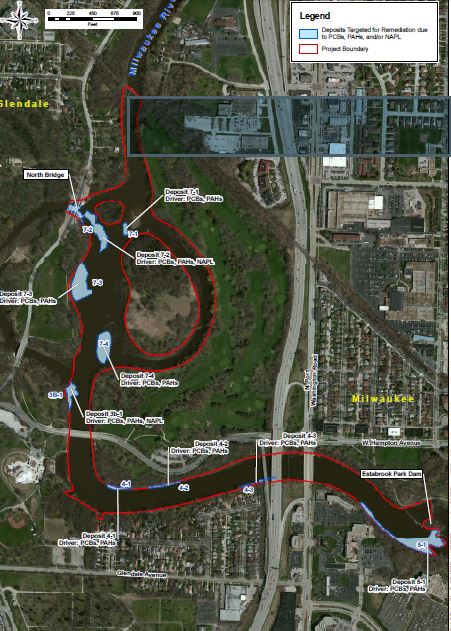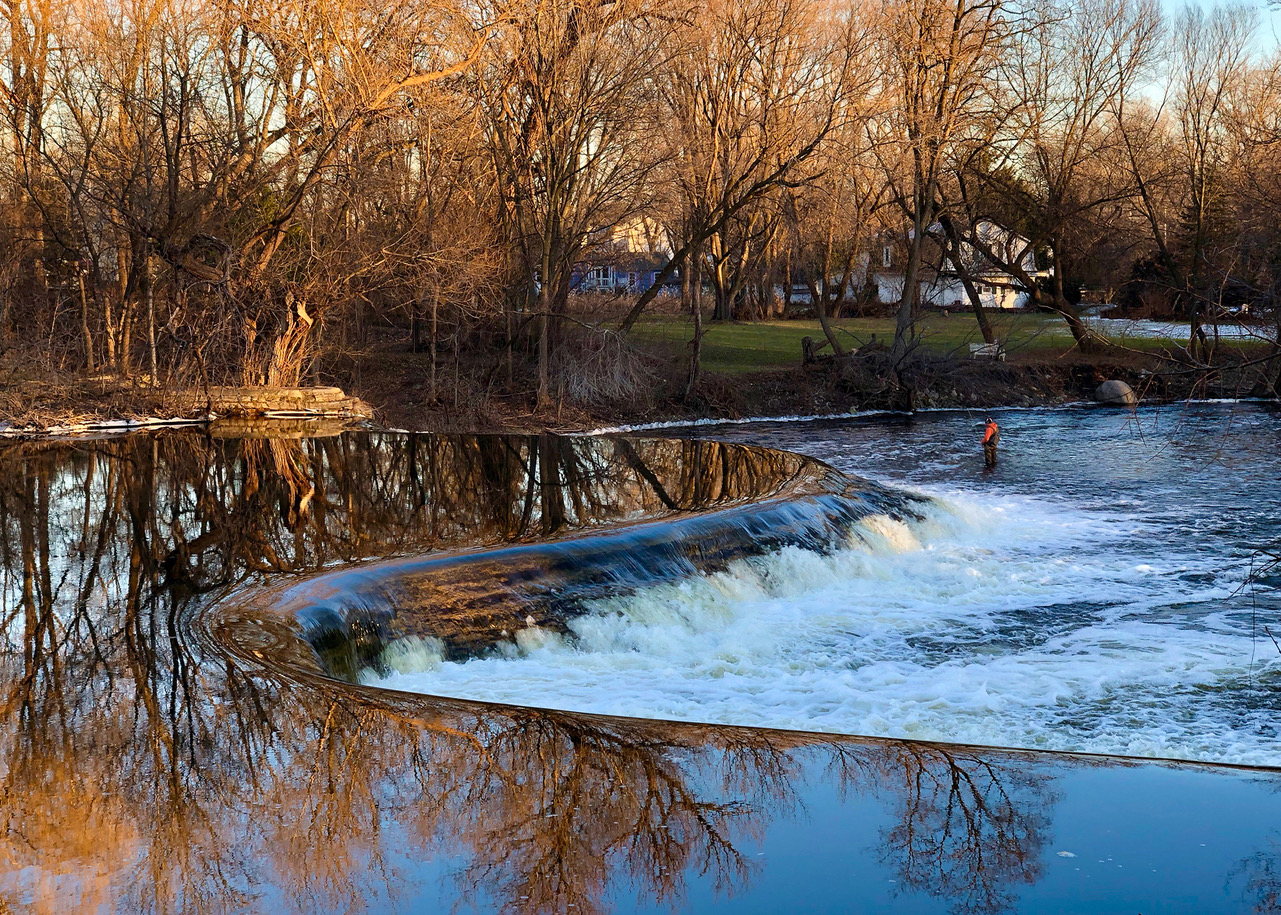Introduction: Delving Deep into the Milwaukee River’s Smallmouth Heritage
The Milwaukee River, gracefully carving through southeastern Wisconsin, has long been recognized for its bountiful smallmouth bass population. As a gem among freshwater fishing venues, understanding its ecosystem and history offers anglers a richer and more immersive fishing experience.
The Smallmouth Bass Population of the Milwaukee River:
Density and Distribution: Smallmouth bass in the Milwaukee River benefit from an expansive range of habitats. The upper reaches, characterized by faster currents and rockier substrates, offer ideal spawning grounds, while the lower sections, with their deeper pockets, support larger, more mature bass populations.
Health and Size: Over the years, conservation efforts and sustainable fishing practices have fostered a healthy bass population in the river. Anglers often report encounters with smallmouth bass in the 3 to 5-pound range, with occasional catches surpassing this.
Forage Base: The river’s diverse ecosystem, abundant with crayfish, minnows, and various aquatic insects, provides a rich diet for the smallmouth bass. This robust food source directly contributes to the bass’s overall health and size in the region.
Historical Significance of Bass Fishing in the Milwaukee River:
Indigenous Fishing Practices: Long before modern anglers cast their lines, indigenous tribes recognized the river’s bounty. The use of primitive fishing gear, like woven nets and traps, was integral in harnessing the river’s resources, with smallmouth bass being a key food source.
Rise in Recreational Fishing: With the urbanization of Milwaukee and surrounding areas in the late 19th and early 20th centuries, the river began to draw attention from recreational anglers. As rod and reel technology advanced, so too did the popularity of bass fishing in the area.
Conservation Efforts: The 20th century saw increasing environmental and conservation awareness. A notable shift was the move from mere extraction to sustainable fishing practices. Angling clubs and local organizations began advocating for catch and release, ensuring the river’s smallmouth bass population would thrive for future generations.
Tournaments and Recognition: Given its prominent smallmouth bass population, the Milwaukee River has been the venue for numerous fishing tournaments over the years. These events not only highlight the river’s significance in the angling world but also bolster local economies and foster community ties.
Navigating Milwaukee’s Best Shore Fishing Spots
Dive into the intricate lay of the Milwaukee River, as we explore the myriad locations ripe for smallmouth bass fishing. From quiet shorelines, the river offers a diverse palette for every angler’s taste.
Fishing Smallies Near Estabrook Park: A Deep Dive
1. Landscape and Terrain:
- Estabrook Park spans a substantial stretch of the Milwaukee River, offering a varied landscape that includes steep banks, sandy flats, and pockets of submerged vegetation. These natural formations make for a diverse habitat for smallmouth bass.
2. Key Fishing Areas:
- Estabrook Falls: Located within the park, the area around these small falls offers deeper pockets of water and swirling currents that smallmouth bass frequent, especially in the early morning and late evening.
- Concrete Structures: Some old man-made structures near the park’s boundaries serve as ideal ambush points for smallmouth bass. These bass often wait behind structures to attack prey that gets caught in the current.
- Sandbars and Shallow Flats: During warmer months, smaller bass can often be seen sunning themselves in these shallower areas, making them prime targets for sight fishing.
3. Techniques & Lures:
- Early Morning & Late Evening: Topwater lures like poppers and walking baits can be particularly effective during these low-light conditions when bass are more active.
- Midday: Soft plastics, especially Texas-rigged worms or tube baits, can tempt bass hiding in deeper pockets or behind structures.
- Swift Currents: In areas with faster-moving water, spinnerbaits and crankbaits can help you cover more water and locate aggressive feeding bass.
- Finesse Fishing: In heavily pressured areas or during tougher fishing days, consider using finesse techniques like drop-shot rigs with smaller soft plastic baits.
4. Seasonal Considerations:
- Spring: As the water warms up, smallies move from their wintering holes towards shallower spawning areas. Target sandy or gravelly flats with soft plastics or jigs.
- Summer: Bass spread out during this time, with larger ones holding in deeper, cooler water during the heat of the day. Topwater action can be great during early morning and evening.
- Fall: As temperatures drop, smallmouth bass become more aggressive, feeding heavily in preparation for winter. Moving baits like spinnerbaits or jerkbaits can be particularly effective.
5. Access and Amenities:
- Estabrook Park provides ample parking, making it easy to access prime fishing spots. Moreover, there’s a beer garden for those looking to enjoy a post-fishing refreshment. Picnic spots, restrooms, and other amenities ensure that anglers and their families can have a fulfilling day out.
Estabrook Park offers more than just scenic beauty; it’s a haven for smallmouth bass enthusiasts. The varied terrain and rich aquatic habitat ensure that, with a little patience and technique, anglers can look forward to a rewarding experience.
Smallmouth Bass Fishing at Lincoln Park: Hook, Line, and Smallies

1. Landscape and Terrain:
- Lincoln Park’s segment of the Milwaukee River presents a range of features: from gradual shorelines with underwater vegetation to deeper holes created by slow meanders in the river. These conditions make it an attractive habitat for smallmouth bass.
2. Key Fishing Areas:
- River Bends: Where the river curves, deeper pockets often form on the outer bends. These areas can hold larger bass, especially during the hotter parts of the day.
- Submerged Vegetation: Near the banks and in shallow flats, the submerged vegetation can be a hotspot for bass. They often use these vegetated areas to ambush prey.
- River Flats: These are shallow areas with a mix of sand and small rocks. During the spawn, these flats become particularly active as bass move in to lay eggs.
3. Techniques & Lures:
- Morning & Evening: During the cooler parts of the day, bass can be found in shallower waters. Topwater lures, such as poppers or whopper ploppers, can produce exciting strikes.
- Midday: When the sun is at its peak, smallies tend to move to deeper, cooler pockets. Soft plastics, like tube baits or swimbaits, can be effective in enticing these more lethargic bass.
- Vegetation Zones: Weedless setups, such as Texas-rigged soft plastics, can be beneficial. Spinnerbaits can also be effective, as their blades can attract bass from within thick vegetation.
- Current Breaks: Bass often position themselves behind large rocks or fallen trees to conserve energy and ambush prey. Casting jigs or soft plastics near these structures can yield good results.
4. Seasonal Considerations:
- Spring: Post-winter, bass will be actively feeding. Target them in shallower flats using soft plastics or crankbaits.
- Summer: Seek out deeper pockets during the day. Early morning and late evening topwater action can be thrilling during this period.
- Fall: Smallies feed aggressively as the temperatures begin to drop. Reaction baits like spinnerbaits and jerkbaits can be highly effective.
5. Access and Amenities:
- Lincoln Park offers convenient access points to the river. There are trails running alongside the river, allowing anglers to scout multiple spots.
- The park itself boasts several amenities, from playgrounds to picnic areas. There are also restrooms and parking facilities, ensuring a comfortable fishing experience.
Lincoln Park’s segment of the Milwaukee River is a haven for smallmouth bass enthusiasts. The combination of natural river features and the park’s amenities make it an excellent choice for both novice and experienced anglers seeking a fruitful and enjoyable day on the water.
Smallmouth Bass Fishing Near Pere Marquette Park: Urban Angling Meets Nature
1. Landscape and Terrain:
- Being in a more urbanized setting, the waters near Pere Marquette Park have a blend of natural and man-made features. Expect to encounter both rocky natural riverbeds and artificial structures like retaining walls.
2. Key Fishing Areas:
- Retaining Walls and Piers: These man-made structures can serve as ideal ambush points for smallies. Fish often patrol these zones looking for prey sheltering from the current.
- Submerged Debris: Over the years, various debris and structures have ended up submerged in this part of the river. Such areas, while requiring caution, can also be hotspots for bass.
- River Bends and Current Breaks: Sections of the river near Pere Marquette Park have varying currents, with some areas having slower water. Bass often use these zones to rest and feed.
3. Techniques & Lures:
- Structure Fishing: Using jigs or Texas-rigged soft plastics around and beneath urban structures can be effective. The aim is to mimic prey that might be hiding or trapped near these structures.
- Drop Shotting: Given the depth variations and submerged structures, a drop shot rig can be ideal to present the bait at the exact depth where bass might be holding.
- Topwater: During early morning or evening, when smallies come to shallower zones, topwater lures like poppers can be very effective.
4. Seasonal Considerations:
- Spring: As bass move from deeper wintering holes to shallower areas for feeding and spawning, target them near structures and slower-moving water with soft plastics.
- Summer: With warmer waters, bass might seek deeper spots or shadowed areas beneath urban structures during the hottest parts of the day.
- Fall: As temperatures drop, smallies become more active and aggressive. Moving lures like spinnerbaits or swimbaits can yield good results.
5. Access and Amenities:
- Pere Marquette Park is conveniently located with easy access to the river. There are pathways, seating areas, and other urban amenities, making it easy for anglers to enjoy their time both fishing and relaxing.
- The park often hosts events and festivals, so be aware of any events that might coincide with your fishing plans.
Pere Marquette Park offers a unique blend of urban fishing with the beauty of nature. The combination of natural river dynamics with urban structures provides anglers with both challenges and rewards, making it an intriguing spot for smallmouth bass fishing in the heart of Milwaukee.
Smallmouth Bass Fishing Near Thiensville Dam
1. Landscape and Terrain:
- The Thiensville Dam area is characterized by the dam’s fast-moving water and deeper pools that form downstream. There are also rocky substrates and underwater structures that serve as habitats for baitfish and, consequently, smallmouth bass.
2. Key Fishing Areas:
- Below the Dam: Just downstream of the dam, the turbulent water creates oxygen-rich zones that attract baitfish and predatory fish alike.
- Deep Pools: Formed by the dam’s water flow, these zones can be resting places for bass, especially during hotter days.
- Rocky Outcrops: These areas provide cover for baitfish, making them prime feeding grounds for bass.
3. Techniques & Lures:
- Crankbaits: Casting these near the rocky areas can imitate baitfish, attracting bass.
- Soft Plastics: Lures like tube jigs and craw imitations can be effective when jigged near the bottom.
- Spinnerbaits: Due to the turbulent water, using spinnerbaits can attract bass from a distance.
4. Access and Amenities:
- There are viewing platforms and some shoreline access points for anglers near the dam. However, always ensure you are fishing in allowed areas and maintaining safety near fast-moving waters.
Smallmouth Bass Fishing Near Kletzsch Park

1. Landscape and Terrain:
- Kletzsch Park is known for its diverse habitats: from rapid cascades to deeper pools, all bordered by a rocky riverbed. The natural terrain here provides ample structure for bass.
2. Key Fishing Areas:
- River Bends: The outer curves of the river bends often hold deeper waters, which can house bigger bass.
- Rocky Shores: These shores are not just picturesque but also productive. They act as highways for bass searching for food.
- Fallen Trees & Logs: Submerged trees can be ideal ambush spots for bass.
3. Techniques & Lures:
- Topwater Lures: Given the clearer water in certain areas, topwater lures can produce exciting strikes during dawn and dusk.
- Jigs: Casting jigs near underwater structures and rocks can entice bites from bass lurking nearby.
- Soft Plastics: Texas or Carolina-rigged plastics and swimbaits can be used to search the riverbed for active bass.
4. Access and Amenities:
- Kletzsch Park offers extensive shoreline access, making it a preferred spot for shore anglers. The park itself is equipped with numerous amenities, including parking, picnic areas, and walking trails.
Both the Thiensville Dam and Kletzsch Park present unique challenges and opportunities for smallmouth bass fishing. With the right approach and understanding of the terrain, anglers can have memorable experiences at these locations on the Milwaukee River.
Smallmouth Bass Fishing Near Grafton Dam: A Blend of Natural and Man-made Challenges
1. Landscape and Terrain:
- Grafton Dam creates a unique water structure with areas of fast-moving water combined with deeper, more stagnant pools downstream. The base of dams often provides oxygen-rich waters, making them an attractive habitat for a variety of fish species.
- The rocky outcroppings and submerged structures in this area are prime spots where smallmouth bass can find shelter and food.
2. Key Fishing Areas:
- Tailwaters of the Dam: Directly downstream from the dam, the turbulence creates ideal conditions for baitfish and subsequently, smallmouth bass. The water’s constant movement ensures it’s oxygen-rich and cool, which attracts bass.
- Rocky Substrates: The dam vicinity has rocky bottoms and structures that are natural habitats for crayfish, one of the smallmouth bass’s favorite prey. Bass often hide near these structures to ambush prey.
- Deeper Pools: These are formed due to the flow of water from the dam. Bass often retreat to these zones, especially during hotter parts of the day or when they feel threatened.
3. Techniques & Lures:
- Jigs: Given the rocky terrain, jigs can be very effective. They can be bounced off the rocks, mimicking the movement of crayfish and attracting bass.
- Crankbaits: Especially useful in the tailwaters and deeper pools. They imitate wounded baitfish, which can entice bass to strike.
- Soft Plastics: Lures like tube jigs or soft plastic crayfish can be worked around the rocky substrates to attract bass lurking nearby.
- Spinnerbaits: Due to the water turbulence near the dam, these can be effective as they’re easily visible and create vibrations in the water.
4. Access and Amenities:
- Grafton offers several access points to the river, with pathways and viewing platforms near the dam. Ensure you’re accessing the river from designated points and maintaining safety, especially if the water is running high.
The Grafton Dam area on the Milwaukee River provides a unique environment for smallmouth bass fishing, offering a mix of challenges and rewards. With the right techniques and respect for safety, anglers can have a memorable time pulling in bass against the powerful backdrop of the dam.
A half mile below Grafton the Milwaukee River braids into several channels for about a half mile. This offers nearly 2 miles of separate channels to fish. This short section may offer the best fishing anywhere in the entire river. Access to this area is from Limekiln Park, a small public park on the west shoreline. Immediately downstream from Limekiln Park is a private community park. Once you get past the parks the islands and shoreline are all wooded. At Limekiln Park there is a short rapid section over a smooth stone bottom followed by a deep pool where the river makes a 90 degree turn against a 15′ high rock cliff. If you are wading this area you will need chest waders and felt soles to get thru here. The channel then starts dividing itself.
https://www.coppersmithstudios.com/pic_milw2.html
Tapping into the dynamic essence of the Milwaukee River ensures an angling experience unlike any other. With the right knowledge and preparation, the river’s bass-rich waters are ready to be explored and conquered. Smallmouth bass, with their tenacious spirit and distinctive fight, are the river’s crowning jewels, making every cast an adventure in anticipation.


